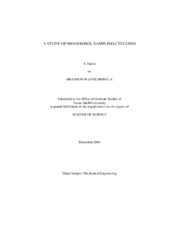| dc.description.abstract | A wetted wall cyclone using an airblast atomizer upstream of the inlet was designed as an improvement of a wetted wall cyclone developed by White et al. in 1975, which uses liquid injection through a port on the wall of the cyclone inlet. In the course of this project, many changes to different aspects of the White-type cyclone design and operation were considered. These included inlet configuration, liquid delivery, porous media, surface finishes and coatings, outlet skimmer design, and cyclone body length.
The final airblast atomizer cyclone (AAC) design considered has an aerosol-to-hydrosol collection efficiency cut-point of 1.6 µm with collection efficiencies at 2 and 3 µm of 65% and 85%, respectively. The efficiency reported for the White-type cyclone for single Bacillus globigii spores that have a particle size of about 1 µm was approximately 81.8%. The aerosol-to-aerosol transmission efficiency for the AAC configuration was found to be approximately 50% for 1 µm diameter particles as compared with 70 – 100% for the White-type cyclone.
A time response test was performed in which the White-type (ca. 2003) cyclone had an initial response of 3 minutes for a condition where there was no liquid carryover through the cyclone outlet and 8 minutes on average with hydrosol carryover. The decay response of the White-type cyclone was 1.25 minutes for non-liquid carryover conditions. The AAC had an initial response of 2.75 minutes and a decay response of
2.5 minutes. The shortened version of the AAC had an initial response of 1.5 minutes and a decay response of 1.25 minutes. There was no liquid carryover observed for any tests of this cyclone configuration.
Power consumption tests were performed comparing pressure drops across different variations of White-type cyclones (circa 2003 and 1999) including a variation with an electrical discharge machined (EDM) inlet profile, that reduces the pressure drop at a nominal air flowrate of 780 L/min from 18 inH2O for the basic White-type cyclone (ca. 2003) to 16 inH2O with use of the EDM inlet. Two different variations of White-type cyclones were found to have pressure drops of 25 inH2O and 18 inH2O at an air flowrate of 780 L/min. | en |


